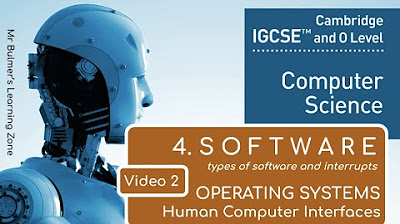Sistem Operasi - Manajemen Memori
Summary
TLDRIn this video, Fitriah Khairani from Politeknik Negeri Padang explains memory management in modern computer systems. She covers the importance of memory as the central storage for information and discusses various types of memory, including registers, primary, cache, and secondary memory. The video delves into memory addressing techniques, such as physical, relative, and logical addressing, and compares memory management in monoprogramming versus multiprogramming environments. Additionally, she highlights memory allocation strategies and the significance of efficient memory management to optimize system performance. Overall, this educational content provides valuable insights into how memory functions within computer systems.
Takeaways
- 📚 Memory is essential in computer systems, serving as the central storage for information that needs to be efficiently managed.
- 🔍 Memory consists of various types, including registers, main memory, cache memory, and secondary memory, each with distinct functions and characteristics.
- ⚙️ Registers are temporary storage locations for data processed by the CPU, such as the Instruction Register for holding executable instructions.
- ⚡ Main memory is volatile and accessible randomly but has slower data transfer speeds compared to execution processes.
- 🚀 Cache memory, although smaller, operates at higher speeds and acts as a temporary copy of frequently accessed data from main memory.
- 💾 Secondary memory is non-volatile storage like HDDs and SSDs, but it has slower transfer rates than main memory.
- 🌀 Virtual memory is a technique used to extend the apparent capacity of main memory, allowing for more efficient process management.
- 🗺️ Memory addressing can be physical, relative, or logical, each requiring different levels of translation during program execution.
- 📈 In monoprogramming systems, only one process can occupy memory at a time, whereas multiprogramming systems allow multiple processes to share memory resources.
- 🔄 Effective memory management involves allocating memory, managing process states, and implementing swapping techniques based on process priority.
Q & A
What is the primary function of memory in modern computer systems?
-The primary function of memory in modern computer systems is to serve as a central storage area for information, facilitating efficient processing and input/output operations.
What are the different types of memory mentioned in the video?
-The video mentions several types of memory: registers, main memory, cache memory, and secondary memory, each with distinct roles and characteristics.
What is the purpose of registers in a computer's memory architecture?
-Registers are used as temporary storage for data that the CPU is currently processing, allowing for quick access, although they have very limited capacity.
How does cache memory differ from main memory?
-Cache memory is smaller and faster than main memory; it serves as a temporary copy of frequently accessed data and instructions to enhance processing speed.
What is the distinction between physical and logical addressing in memory management?
-Physical addressing directly corresponds to actual memory locations, while logical addressing allows for flexible program relocation in memory and may require translation during execution.
How does monoprogramming differ from multiprogramming in memory management?
-In monoprogramming, only one process occupies the entire memory area at a time, while in multiprogramming, multiple processes can share the main memory simultaneously.
What are the advantages of contiguous memory allocation?
-Contiguous memory allocation simplifies management by ensuring processes occupy a single block of memory, reducing fragmentation and allowing for faster execution.
What challenges does non-contiguous memory allocation present?
-Non-contiguous memory allocation requires more complex management to handle scattered memory spaces and may lead to inefficient memory usage.
What is the role of swapping in memory management?
-Swapping involves temporarily transferring processes in and out of memory to optimize resource usage, allowing higher-priority processes to access memory when needed.
Why is it important to manage memory efficiently in computer systems?
-Efficient memory management is crucial to maximize resource utilization, minimize delays in process execution, and maintain overall system performance.
Outlines

此内容仅限付费用户访问。 请升级后访问。
立即升级Mindmap

此内容仅限付费用户访问。 请升级后访问。
立即升级Keywords

此内容仅限付费用户访问。 请升级后访问。
立即升级Highlights

此内容仅限付费用户访问。 请升级后访问。
立即升级Transcripts

此内容仅限付费用户访问。 请升级后访问。
立即升级浏览更多相关视频

Operating system concept P1 week1

IGCSE Computer Science 2023-25 - SOFTWARE: Video 2 - THE OPERATING SYSTEM

1. How a Computer works

Paging in Operating Systems with Example & Working - Memory Management

Computer Concepts - Module 4: Operating Systems and File Management Part 2 (4K)

Bentuk Negara, Bentuk Pemerintahan, dan Sistem Pemerintahan.
5.0 / 5 (0 votes)
